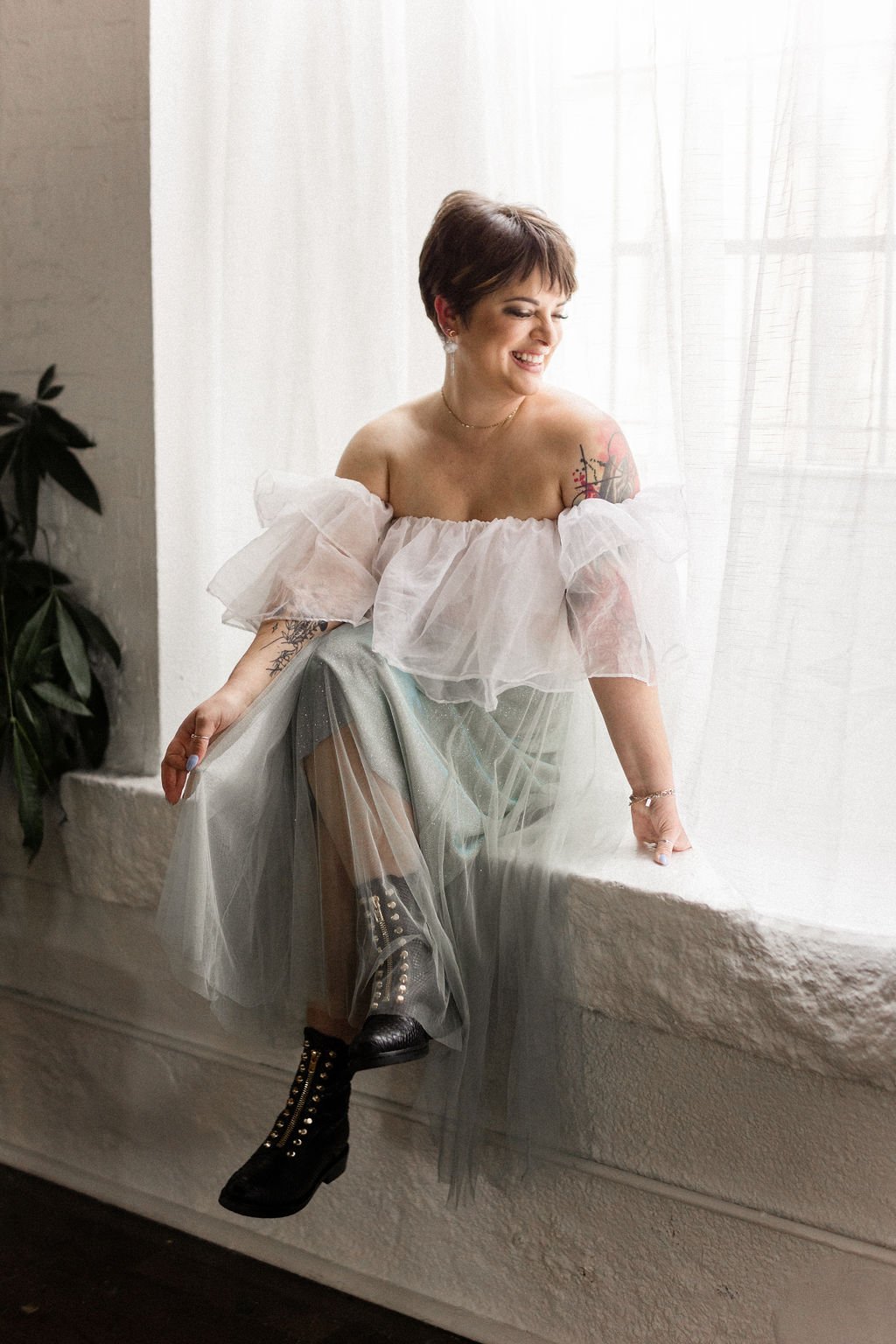Beyond Rainbows: Style in the Queer Community
By Susan Padron
Photography by Jessica Lynn Photography
Sexuality and gender are spectrums, and so is your personal style. Your style is an extension of you. In order to fully connect with yourself, you need to feel comfortable reflecting who you are through your clothes. What that looks like varies depending on the individual, but style is one theme that has helped queer folks to connect with one another.
Brief History of Queer Style
Even in 2023, it’s not always safe for someone who is part of the LGBTQIA+ community to be visibly “out”. As a way of trying to stay under the radar, folks choose different approaches of expressing themselves in quiet ways to help find other queer people.
One of the most well known examples of this dates back to the 1890’s with Oscar Wilde and his green carnation. In a time when you could be imprisoned for being queer (Wilde served 2 years in prison for being homosexual), Oscar Wilde wore a green carnation on his jacket lapel to subtly signal that he was gay. This became a trend, and soon other gay men started doing the same.
From the 1940’s through the 1960’s, police were arresting people for “cross-dressing”, using an informal “three-article” rule as justification. During this time, a person was required to be seen wearing at least three pieces of clothing that “belonged” to their assigned gender. The Stonewall riots occurred in 1969, which were a direct rebellion against the police brutality the queer community had been experiencing. Following the riots, queer style really started to evolve as a way of continuing that rebellion. The 1970’s were a time when women started to outwardly rebel against societal norms. They started to intentionally dress in ways that were in opposition to the male gaze. The 70’s were also the beginning of drag balls, which allowed for a safe space for folks to wear clothes traditionally worn by the opposite gender.
In the 1980’s, the rebellion against societal expectations continued with “alternative” subculture styles like grunge and club kid styles. Grunge and punk both in their style and music were inherently “anti-establishment”, rebelling against the norm, and welcoming to the “outsiders”.
Due to the tragedy of the AIDS epidemic in the 80’s and 90’s, there became a lot of fear and backlash towards gay men. So, in the 1990’s, gay men used a single ear piercing in the right ear to show that they were queer, a much more subtle message similar to Oscar Wilde’s carnation worn almost a century prior.
Social Media’s Impact on Style Visibility
Tiktok has allowed for a space where all kinds of creators can show off their personal style. Because it’s such a popular platform, especially with Gen Z, we’re able to watch billions of fashion themed videos. If you’re on the queer side of Tiktok, you’ll definitely start to notice trends and commonalities in queer styles. Before we dive in here, allow me to say that there’s no right or wrong way to dress as a queer person. You can be queer, dress like your most authentic self, and not wear a single one of these trends that I list below, or you can wear one or all of them. Again, just like gender and sexuality, personal style is a spectrum.
Let’s say you’re on queer Tiktok, and you come across some GRWM (get ready with me) videos, here are the trends that you’re likely to notice.
In masc folks, the trends we tend to see in the queer community are nostril piercings, crop tops, short shorts, skirts, dresses, deep v-neck style tops/button downs, fishnets, leather clothing, mesh tops, sleeveless shirts, and harnesses.
For femme queer folks, you’ll often notice septum piercings, oversized t-shirts, strappy tops, oversized pants, oversized button downs, harness, doc martens, combat boots, knit beanies, bike shorts, tattoos like moths or the moon cycle, and fishnets.
Nonbinary style does not have to be exclusively androgynous. There is no right or wrong way to be nonbinary. You can dress in an androgynous way without being nonbinary, and you can dress masc or femme and be nonbinary.
A commonality you will find throughout a lot of queer style videos is thrifting. More and more, people are thrifting as an attempt to try to help battle fast fashion, one of the biggest pollutants on the planet. By thrifting or shopping secondhand, it’s easier to find inexpensive clothes, without supporting fast fashion. Shopping secondhand is also popular because it allows people to find unique pieces with the ease and accessibility to all kinds of clothes without the discomfort of shopping in a boutique or a department store. Because most stores are so divided with gender, it can be uncomfortable for someone to shop in a section that looks different than their perceived gender. Thrift stores don’t have that same kind of layout, so it feels safer to shop around.
Why is queer style important?
One of the main reasons why queer style is important, is because it allows the LGBTQIA+ community to dress in ways where they feel seen. Every single day, the queer community is battling hate, on an individual level or on a larger scale. To be able to be in a group of people, and see something as subtle as a tattoo or a piercing, and know, “I’m with my people” allows you to exhale, even if just for a minute.




